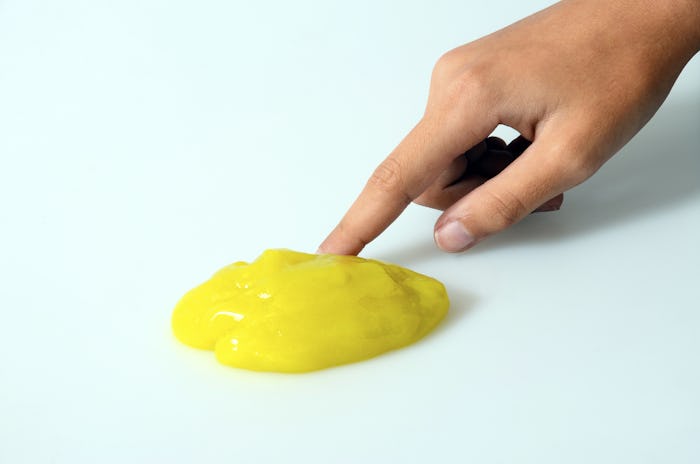Life
How To Fix Hard Slime With Ingredients You *Definitely* Have Lying Around The House
Slime is a make-at-home, do-it-yourself science project masquerading as art, that even craft-challenged people can undertake. But what happens when you gather the ingredients, put everything into a bowl, and, sadly, the whole thing is too hard? Or what if you've had the slime for a while and find that over time it got too stiff and useless? Don't freak out because we can tell you what to do when your slime is too hard.
DIY slime projects sounds so easy, but it doesn't take much to throw the whole thing off and make it too stretchy, too goopy, or too hard. If you find it's too stiff, often all that's needed to reinvigorate your slime is the addition of one or two ingredients. The softeners may vary based on what type of slime you have created. Many slime recipes call for glue (like Elmer's), baking soda and saline solution. Other recipes substitute borax for the baking soda and saline. Make sure to follow the recipe carefully because what you are actually doing is creating a chemical reaction between the ingredients that causes the slime to start sticking together. It's not quite a liquid, not quite a solid. Maddie Rae's Slime Making website refers to it as a "non-Newtonian fluid" in honor of Sir Isaac Newton, who the site describes as doing, "a ton of work with mathematics, gravity, motion, and fluids." The more you knead it, the more the molecules cling to each other and the more it becomes the slime you would expect.
Unfortunately, you can follow everything to the perfectly-measured T and still end up with a #fail. Not to worry — there are plenty of ways to troubleshoot your slime before you decide to throw the whole thing in the garbage. To warn you, it may get messier before it really starts to come together, but it'll be worth the patience. And even in failure, your kids may still learn something about chemistry.
Hand Lotion
WikiHow has several suggestion on how to medic your hard slime but one is so simple, it seems too obvious — just add a spoonful or two of hand lotion and a splash of water. Put in a little at a time, knead and see how it goes. Still too hard? Add a little more. It's like softening your skin, only you're doing it to your slime.
Water
This method was created by Talisa Tossell, whose video on You Tube has over 7 million views (which means there are many people around the world who have slime fails). To start, divide the hard slime into quarters, add boiling water (make sure you supervise young kids) and some more activator and piece by piece soften the slime to a consistency that's easy and fun to play with. This one may take a while because the boiling water will make the slime too hot to touch at first, so you'll have to start off mixing it with a spatula before you can get your hands in it.
Alternatively, Slime Bun Shop (a Canadian company that sells slime) has a simple troubleshooting tips for hard, even cracked, slime. They suggest adding warm water, a little at time, then kneading, then adding more. Keep at it until the slime feels more malleable.
Antibacterial Gel
Another one of WikiHow's tricks is to use some antibacterial gel on your hard slime. Use a drop or two at a time, then mix the slime with a spoon. Bonus: this method will also keep the germs away.
Check out Romper's new video series, Bearing The Motherload, where disagreeing parents from different sides of an issue sit down with a mediator and talk about how to support (and not judge) each other’s parenting perspectives. New episodes air Mondays on Facebook.
